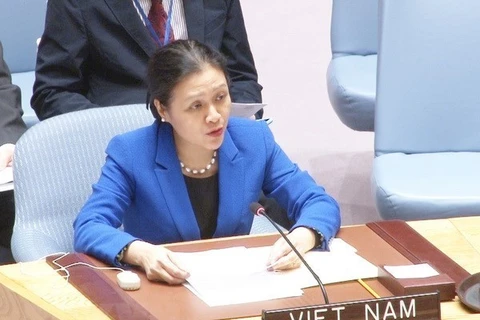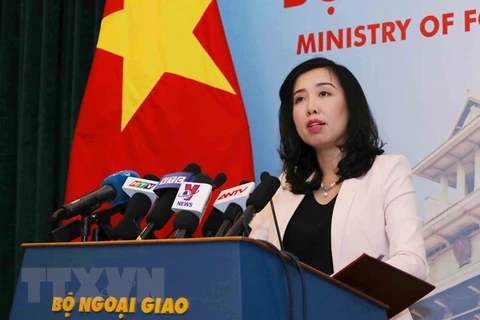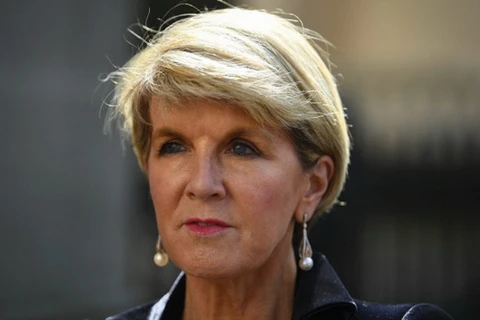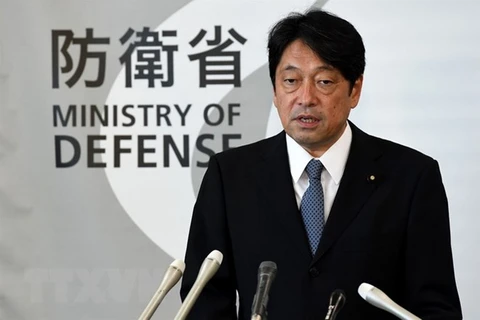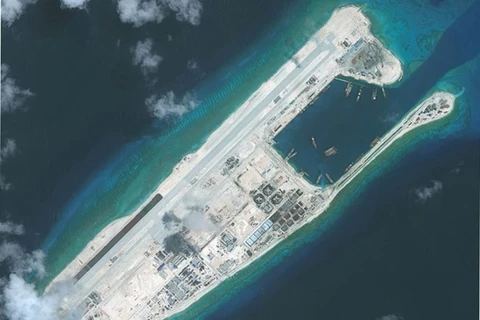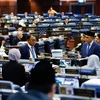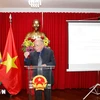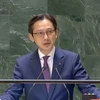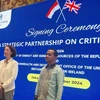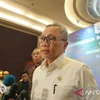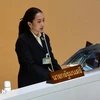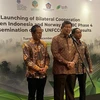 An aerial photo of an illegal airfield that China built on Fiery Cross Reef of Vietnam's Truong Sa archipelago (Photo: AFP)
An aerial photo of an illegal airfield that China built on Fiery Cross Reef of Vietnam's Truong Sa archipelago (Photo: AFP) Hanoi (VNA) – Chinese bombers’ landing and take-off drills on an airfield in Hoang Sa (Paracel) archipelago, which belongs to Vietnam but is occupied by China, are causing deep concerns and facing strong opposition from many countries regionally and globally.
After an array of activities to illegally reclaim and construct military facilities and bases in the East Sea and the deployment of weapons on artificial islands that were illegally built in Truong Sa (Spratly) archipelago, China’s latest move in Hoang Sa has evidenced the country’s continued acceleration of militarising the East Sea regardless of international opposition.
Japanese Defence Minister Itsunori Onodera said this is the next step of China to unilaterally change the status quo in the East Sea. Meanwhile, spokesman of the US Pentagon Christopher Logan said China’s continued militarisation only serves to raise tensions and destabilise the region.
At the ongoing G20 foreign ministers’ meeting in Buenos Aires of Argentina, Australian Foreign Minister Julie Bishop raised her country’s concerns about China’s militarisation in the East Sea.
Philippine presidential spokesman Harry Roque also expressed serious concerns on the move’s impact on efforts to maintain peace and stability in the region.
This is not the first time China’s unilateral military moves have encountered international criticism.
In early May 2018, in response to the Chinese missile deployment in the structures that it built illegally in Vietnam’s Truong Sa archipelago, the US warned about near-term and long-term consequences, noting that China cannot and should not have a hostile attitude in the East Sea.
Chief of the US Pacific Command Admiral Philip Davidson, who took office on May 18, said China’s actions affirm its intention to control the East Sea.
Echoing the view, Gregory Poling, a fellow at the Centre for Strategic and International Studies, said China is crossing an important threshold. The missile deployment is a clear threat to other claimants and furthers China’s goal of establishing complete control over the water and airspace of the East Sea.
China’s deployment of weapons in the structures it illegally built in the East Sea and its large-scale military moves in the waters clearly run counter to commitments the country made not to militarise the East Sea.
This is also contrary to the Declaration on the Conduct of Parties in the East Sea (DOC), signed by China and the member states of the Association of Southeast Asian Nations (ASEAN) in 2002, which requires the countries to maintain the status quo and not complicate the East Sea situation.
Moreover, China made these moves when it and the ASEAN countries reached an important common perception in together building a Code of Conduct (COC) of parties in the East Sea towards a transparent and rule-based regional architecture and an East Sea of peace and stability.
The Chinese moves undermine and hamper negotiation efforts to finalise the COC, which aims to create prerequisites for the settlement of East Sea disputes and maintain peace, stability, security and safety of navigation in the region.
China’s deployment of bombers and missiles in the East Sea has run counter to international law and seriously violated Vietnam’s sovereignty, in both legal and historical aspects, over Hoang Sa and Truong Sa archipelagoes.
Those activities have affected the friendship and comprehensive strategic cooperative partnership between Vietnam and China. They have also breached the two countries’ agreement on basic principles guiding the settlement of sea-related issues as well as the common perception shared between the countries’ leaders to solve obstacles in the East Sea issue. The two sides previously agreed to continue implementing the DOC in a comprehensive and effective manner, soon build the COC, control sea-related disagreements well and not take actions complicating the situation.
China’s sending of weapons to illegal structures in Hoang Sa and Truong Sa only raises tensions and blights trust among parties involved in the East Sea issue.
As a big country with an important role in the international arena, China has the responsibility to adjust its behaviour in the East Sea on the basis of international law, end all unilateral actions complicating the situation, show a constructive attitude and contribute to the maintenance of peace, stability, friendship and cooperation in the region.-VNA
VNA
